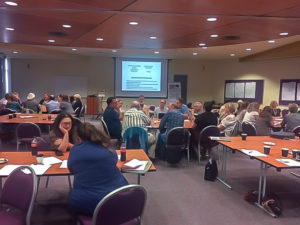This is the second of two blogs about taking the Power Threat Meaning Framework to New Zealand and Australia. The PTMF is an ambitious attempt to outline a conceptual alternative to psychiatric diagnosis and the medicalisation of distress, funded by the Division of Clinical Psychology of the British Psychological Society, and launched in London in January 2018 (Johnstone and Boyle, 2018a; Johnstone and Boyle, 2018; click here for relevant documents, videos and other resources). The hosts were ISPS (the International Society for Psychological approaches to Psychosis) in both countries, collaborating with the Blue Knot Foundation in Australia.
The first blog describes a two day workshop in Auckland with Lucy Johnstone. One of the aims was to explore whether non-Western experiences and expressions of distress could be compatible with the PTMF. As we phrased it in the document:
The PTM Framework predicts and allows for the existence of widely varying cultural experiences and expressions of distress without positioning them as bizarre, primitive, less valid, or as exotic variations of the dominant diagnostic or other Western paradigms….Viewed as a metaframework that is based on universal evolved human capabilities and threat responses, the basic principles of the PTM Framework apply across time and across cultures. Within this, open-ended lists of threat responses and functions…. allow for an indefinite number of locally and historically specific expressions of distress, all shaped by prevailing cultural meanings (Johnstone and Boyle, 2018a, p. 22).
The Auckland workshop was held in a marae, a communal Māori meeting place or sacred space, and featured Māori traditional rituals and speakers. As described in the blog, Lucy found this a fascinating and enriching experience. The recounting of Māori creation stories or purakau seemed to illustrate the importance of going beyond conventional evidence-based practice and historical truth so that we can also consider ‘narrative truth’ (Spence, 1982, quoted in Johnstone and Boyle, 2018a, p. 83), and value stories according to whether they seem to ‘fit’ in a way that ‘makes change conceivable and attainable’ (Schafer, 1980, quoted in Johnstone and Boyle, 2018a, p.82). The Māori stories seemed to display themes that could be described as power, threat, and meaning, thus illustrating commonalities with the PTMF core themes. The attenders strongly endorsed the PTMF’s inclusion of causal factors that are omitted from most psychiatric and psychological models, such as the impact of colonialism, intergenerational trauma, denial and loss of traditional knowledge, and the role of ideological power in all these areas.
The Australian context
This is a brief summary for readers from outside Australia.
The position of Aboriginal and Torres Strait Islanders, who together make up about 3.3% of the population – is in some ways very different from that of Māori, whose equal rights to Europeans were enshrined in the Treaty of Waitangi of 1840. Aboriginal people had inhabited Australia for around 60,000 years when Europeans began to make intermittent landings from the early 17th century onwards. Captain James Cook charted the East Coast in 1770 but there was little British interest in the new continent until it was proposed as offering a solution to overcrowded prison hulks. This led to the arrival of the First Fleet in 1788 with its cargo of convicts, and the establishment of a colony at what was later named Sydney. The unique spiritual relationship of indigenous people to their land facilitated the idea that Australia was ‘terra nullius’ – belonging to no one, and thus open to possession by Europeans. This is in contrast to the Maori whose warlike defence of their land and country seems to have contributed to a greater degree of respect from early colonisers.
One of the first accounts of the convict origins of the new colony is found in Robert Hughes’ ‘The Fatal Shore’ (1987). The story of the impact of colonisation on indigenous Australians has been even slower to find a place in general consciousness. Captain Arthur Phillip, commander of the First Fleet, ordered that no harm was to be done to the natives so that cordial relationships could be established. However, this quickly broke down and Hughes suggests that racism towards indigenous Australians can be traced back to the convicts’ need to identify a group of lower status than themselves. Before Darwin, beliefs about human racial inferiority took one of two forms. Monogenist theories supposed that all humans have degenerated from the perfection of the Garden of Eden, but darker skinned peoples have degenerated more (largely due to the influence of climate). Polygenist theories held that the Bible was merely allegorical, and that darker skinned people represented a wholly separate and inferior species. Under colonialism, both sets of beliefs could be used to justify brutal acts and policies.
As the British made incursions into the continent, death by disease was succeeded byat least 270 frontier massacres over 140 years, as part of a state-sanctioned and organised attempt to eradicate Aboriginal people. Starting in 1794, mass killings were first carried out by British soldiers, then by police and settlers, in militia-style forces supported by colonial governments. The scale is almost unthinkable: more than 65,000 Aboriginal and Torres Strait Islander people were killed in massacres or conflicts between 1788 and 1930 in Queensland alone. Their total numbers fell from an estimated 770,000 at the time of the invasion in 1788 to a low of around 117,000 people in 1900. There were almost no formal sanctions for these genocidal atrocities.
The Aborigines Act of 1905 granted the State extraordinary powers to intern Aboriginals in missions and reserves, remove their children, and impose a regime of servitude and destitution. The ‘Stolen Generations’ refers to the forcible removal of up to one in 10 children of Aboriginal, ‘part-Aboriginal’ or Torres Strait Island descent, who were placed in institutions and with foster parents, with the intention of assimilating them into the white world. The practice continued from the 1900s until the 1980s, and has been a devastating source of abuse, brutality and intergenerational trauma affecting just about every indigenous family, as described in the report ‘Bringing them home’ (Human Rights and Equal Opportunity Commission, 1997.)
The repeal of the Aborigines Act in 1967 and the granting of citizens’ rights after a Commonwealth Referendum was a significant step towards reclaiming not just political equality – including land rights – but also identity. In 2008 the then prime minister made a formal apology for the Stolen Generation practices. A number of other reports and action plans have set targets for eliminating health inequalities in indigenous peoples, and have led to the establishment of culturally-appropriate mental health services in some areas. However, in Australia, as in other countries with a history of colonialism – including of course the UK – this history continues to resonate, along with widespread negative stereotypes of non-white people in general.
Aboriginal and Torres Strait Islanders peoples have thus faced systematic destruction of their race, their culture and their identity. This is increasingly acknowledged in official documents and policies, but much remains to be done. The Uluru Statement of 2017 calls for ‘a process of agreement-making between governments and First Nations and truth-telling about our history’ and the present Labor government has supported the proposal for this Makarrata, or truth-telling, process.
Like Mâori and Pacific Islanders, Aboriginal and Torres Strait Islanders have a holistic conception of wellbeing that includes spirituality and relationship to the natural world. There is no single Aboriginal culture, given the multiple kinship groups, tribes and languages, but a core feature is a deeply-felt spiritual connection with the land, or ‘country’, and a corresponding sense of dislocation and loss of identity which results from displacement from these ancestral territories.
Given the context outlined above, the shockingly high rates of ‘mental illness’, addictions, and suicide in indigenous Australians are not surprising. Compared to non-indigenous Australians, Aboriginal people report two and a half times the rate of psychological distress; 1.7 times higher admission rates to psychiatric hospital; twice the suicide rate; and two and a half times the hospitalisation rate for alcohol problems. Adults are imprisoned 14 times more often, and juveniles are imprisoned 23 times more often; in fact Aboriginal people are said to have the highest incarceration rates anywhere in the world. There is a similar picture for Torres Strait Islanders (Dudgeon, Milroy and Walker, 2014).
Recent reports have started to acknowledge this painful history and its consequences. The document ‘Working Together: Aboriginal and Torres Strait Islander mental health and wellbeing principles’ (Dudgeon, Milroy and Walker,2014) is based on these Guiding Principles (p.xxiv):
- Aboriginal and Torres Strait Islander health is viewed in a holistic context that encompasses mental health and physical, cultural and spiritual health. Land is central to wellbeing. Crucially, it must be understood that while the harmony of these interrelations is disrupted, Aboriginal and Torres Strait Islander ill health will persist.
- Self-determination is central to the provision of Aboriginal and Torres Strait Islander health services.
- Culturally valid understandings must shape the provision of services and must guide assessment, care and management of Aboriginal and Torres Strait Islander peoples’ health problems generally and mental health problems in particular.
- It must be recognised that the experiences of trauma and loss, present since European invasion, are a direct outcome of the disruption to cultural wellbeing. Trauma and loss of this magnitude continue to have intergenerational effects.
- The human rights of Aboriginal and Torres Strait Islander peoples must be recognised and respected. Failure to respect these human rights constitutes continuous disruption to mental health (as against mental ill health). Human rights relevant to mental illness must be specifically addressed.
- Racism, stigma, environmental adversity and social disadvantage constitute ongoing stressors and have negative impacts on Aboriginal and Torres Strait Islander peoples’ mental health and wellbeing.
- The centrality of Aboriginal and Torres Strait Islander family and kinship must be recognised as well as the broader concepts of family and the bonds of reciprocal affection, responsibility and sharing.
- There is no single Aboriginal or Torres Strait Islander culture or group, but numerous groupings, languages, kinships and tribes, as well as ways of living.
- Furthermore, Aboriginal and Torres Strait Islander peoples may currently live in urban, rural or remote settings, in urbanised, traditional or other lifestyles, and frequently move between these ways of living.
- It must be recognised that Aboriginal and Torres Strait Islander peoples have great strengths, creativity and endurance and a deep understanding of the relationships between human beings and their environment.
Similarly to the New Zealand Government Inquiry comments on Mâori and Pacific Island oppressions, the document acknowledges …‘the enduring legacy of colonisation on Aboriginal life has…affected multiple generations and extends to all dimensions of the holistic notion of Aboriginal wellbeing….. This has resulted in…..unresolved grief and loss; trauma and abuse; violence; removal from family; substance misuse; family breakdown; cultural dislocation; racism and discrimination; exclusion and segregation; loss of control of life; and social disadvantage.’ There has been a call for ‘….Raising awareness about the inappropriate application of western mental health models to Aboriginal and Torres Strait Islander peoples….recognising the importance of connection to land, culture, spirituality, ancestry, family and community, and how these affect individual’s wellbeing’ (p.99.)
However in the same document, a chapter titled ‘Mental Illness in Aboriginal and Torres Strait Islander Peoples’ discusses, without any apparent sense of contradiction, the importance of making accurate diagnoses of ‘mood disorders, psychosis, personality disorders’ and so on in First Nation people. Meanwhile, a current Royal Commission into Mental Health in the state of Victoria has, unbelievably from a UK perspective, no consumer representation at all, along with a failure to acknowledge the potential harms of medicalisation and a corresponding lack of emphasis on trauma and adversity in all their forms, as noted by the leading Victorian consumer organisation (Victorian Mental Illness Awareness Council, 2019). Our impression was that the whole Australian mental health system is more biomedically based than in the UK, with therapy virtually unavailable in community mental health teams or hospitals, very high prescribing rates, and liberal use of labels like ‘schizophrenia’. We were horrified to hear that ‘shackling’, or restraining people with Velcro strips and nets, is common practice.
The workshop in Adelaide
Lucy and John will now describe the 2 day workshop in Adelaide, hosted by ISPS Australia and organised by its current chair Matt Ball. Matt was born in the UK and trained as a psychiatric nurse after recovering from ‘schizophrenia’. He has worked in an Aboriginal community and now runs a private clinic along with therapist Stephanie Mitchell which offers non-medical, trauma-informed interventions. He was named Australian Nurse of the Year in 2017.
One sign of greater acknowledgement of the rights of Aboriginal and Torres Strait Islander people is the ‘Welcome /Acknowledgement to country’ that is standard at all events. Thus, the Adelaide workshop opened with the statement: ‘Our workshop is being held on the land of the Kaurna people and we acknowledge them as traditional owners and custodians of the land we meet on. We pay our respects to elders past, present and emerging and to Aboriginal Torres Strait Islander elders of other communities who may be here today’.
In contrast to the Auckland workshop, it proved very difficult to find an indigenous contributor. We understand that relatively few such speakers exist, and that representation of these minority ethnic groups at conferences and workshops is, unlike in New Zealand and the UK, far from standard. We were extremely fortunate that Tanya Hunter, a Ngarluma (Pilbira) /Nyikina (Kimberleys) woman offered to step in at the last minute.
The first day was spent outlining the PTMF to an enthusiastic mixed audience of MH professionals, peer workers and service users/consumers. Matt generously allowed us to use his story as an illustration of the PTMF principles. Like many psychiatric-patients -turned-campaigners, he found healing through mainly non-medical means, including time spent with homeless Aboriginals in Perth. Within this group, almost as marginalised as those who like Matt are designated as ‘chronically mentally ill’ (although there is overlap), he was able to find a sense of connection – an impetus for his subsequent work with these communities.

On the second day, Bernard Guerin, professor at the University of South Australia, Adelaide, shared some of his work with First Nation peoples. A critic of the individualising assumptions of traditional psychology, he is interested in community research, practice and intervention, drawing on his experiences of living with and working alongside indigenous, refugee and migrant communities.
One of his most compelling articles vividly shows the extra layers of injustice implied in application of psychiatric constructs such as ‘borderline personality disorder’ to Aboriginal people (Fromene, Guerin and Krieg, 2014). The extract below, with official DSM criteria in italics and the historical context added below, shows how this plays out:
‘Frantic attempts to avoid real or imagined abandonment’
Decades of forced separation from caregivers and family
‘Identity disturbance: marked and unstable self-image or sense of self’
Loss of family, kinship system, land and country
‘Recurrent……self-mutilating behaviour’
‘Sorry cuts’ as a traditional way of marking a death
‘Chronic feelings of emptiness’
Grief and hopelessness from cumulative loss, trauma and disempowerment
‘Inappropriate, intense anger or difficulty controlling anger’
Legacy of collective trauma through victimisation, forced assimilation, discrimination from judicial, health and education systems.
A more specific example is given by one of Matt’s clients, here called ‘Mandy’, who is an Aboriginal woman: ‘When returning to country, Mandy has had experiences of seeing emu feathers fall from the sky. The feathers are culturally relevant and remind her of times of making feather flowers that help support her family when she was a child. The emu is her mother’s totem, and seeing the feathers showed Mandy that she was now safe back on country, having been on country of other peoples. The MH system identified the presence of the feather as “prodromal psychosis”’.
There could hardly be clearer examples of what the PTM Framework, quoting Spivak 1988, calls ‘epistemic violence’, a situation in which a discourse is imposed on a subordinate, silenced group, thus facilitating further and more overt forms of violence or oppression.
It was probably Tanya’s story that had the most powerful impact on the audience. Certainly this was true for Lucy, John, Matt and many others. Speaking spontaneously and without notes, she described a horrific, though tragically common, series of events rooted in wider racism and abuses of power. Tanya’s mother was removed from her family of origin and partly as a result of this, was ill-equipped to nurture her own children. Tanya was one of 9 siblings, including a twin sister, 7 of whom were removed and placed separately. Tanya was taken to an orphanage where nuns forbade her from speaking her own language, and social workers later sent her, arbitrarily and with no notice, to a series of foster homes, where she experienced neglect and abuse. Homeless at age 16, she emigrated to the US to try and build a new life for herself, but ended up in a violent relationship, using drugs and lucky to survive an overdose. She is acutely aware of how, despite all her efforts, history repeated itself when she found herself unable to care for her own children, who were removed from her.
Tanya now describes herself as an activist who is training as a social worker in order to challenge and change policy from the inside, and studying anthropology as one of the ways of re-visiting her own history and culture. Asked how she managed to get to this place from such trauma and hardship, she told us that a strong Aboriginal sense of spirituality and connection with ancestors, who ‘walk with us all the time’, has always been with her at her darkest moments. She sometimes experiences this through voices and visions of them guiding and comforting her. She distinguishes these voices from the hostile, critical ones that echo the messages of colonisation by the system.
The PTMF makes reference to the impact of colonialism and intergenerational trauma, and the need to integrate mind, body, spirit, community and the natural world. We also included, as possible ways of reclaiming power and agency, culture-specific meanings, beliefs and forms of expression, spirituality, and reclaiming identity, culture and heritage. As someone who had felt the impact of these abuses of power first hand, Tanya strongly endorsed these themes in the PTMF, and started her talk by saying: ‘The PTMF is relevant to Aboriginal people in this country and indigenous people the world over.’ She has yet to take perhaps the most important step in her healing – returning to her ancestral country in the north west.We are sure she will not only get there, but will also become a powerful force for change in her chosen profession.
Reflections
For Lucy and John, the whole workshop was a very powerful experience. Along with the usual content and debate, we were faced with the immense pain of the stories of indigenous Australians, compounded by psychiatric imperialism. We were also reminded once again that like the Maori and Pacific Islanders, First Nation Australians have an awareness of community, spirituality, identity and connection to the natural world that has been disastrously eroded in Westernised countries, with profound impacts on all aspects of our wellbeing.
The questions that Lucy posed at the workshop in Auckland are equally relevant in Adelaide: ‘Is the Western diagnostic paradigm simply another form of colonialism, perhaps more subtle than earlier versions, but equally damaging in its impacts? Will reports and inquiries go far enough in achieving the longed-for ‘paradigm shift’ ? Or will we simply end up with better-resourced versions of what we already have? Is it legitimate to offer the failed Western diagnostic model alongside indigenous ones, or does it need to be abandoned altogether?’
Tanya described how her ancestors visited her after the workshop, and told her that the opportunity to speak with Matt, a white fella, standing alongside her and supporting her was destined to happen as part of her healing. Her ancestors wanted to show how when we recognise trauma and really listen to each other, we can come together in unity.
We are extremely grateful to the speakers and workshop contributors of all backgrounds who generously shared their thoughts and stories, and whose contributions will further shape the PTM Framework.
Lucy Johnstone, Consultant clinical psychologist and John Cromby, Professor of Psychology.
References
Fromene, R, Guerin, B & Krieg, A (2014) Australian Indigenous Clients with a Borderline Personality Disorder Diagnosis: A Contextual Review of the Literature. The Psychological Record, 64, 559-567.
Dudgeon, P., Milroy, H., & Walker, R. (Eds.) (2014). Working Together: Aboriginal and Torres Strait Islander Mental Health and Wellbeing Principles and Practice. (2nd Edition) Canberra: Commonwealth of Australia.
Human Rights and Equal Opportunity Commission (1997). Bringing Them Home: Report of the National Inquiry into the Separation of Aboriginal and Torres Strait Islander Children from their Families. Canberra; 1997.
Johnstone, L. & Boyle, M. with Cromby, J., Dillon, J., Harper, D., Kinderman, P., Longden, E., Pilgrim, D. & Read, J. (2018a). The Power Threat Meaning Framework: Overview. Leicester: British Psychological Society.
Johnstone, L. & Boyle, M. with Cromby, J., Dillon, J., Harper, D., Kinderman, P., Longden, E., Pilgrim, D. & Read, J. (2018b). The Power Threat Meaning Framework: Towards the identification of patterns in emotional distress, unusual experiences and troubled or troubling behaviour, as an alternative to functional psychiatric diagnosis. Leicester: British Psychological Society.
Spivak, G.C. (1988). Can the subaltern speak? In C. Nelson & L. Grossberg (Eds.) Marxism and the interpretation of culture(pp.271-313). Urbana: University of Illinois Press.
Victorian Mental Illness Awareness Council, 2019. https://www.vmiac.org.au/wp-content/uploads/2019/01/Mental-Health-Royal-Commission-Terms-Reference.pdf
The Power Threat Meaning Framework documents and resources are available here.




A powerful and moving account of the negative consequences of historical abuse and cultural neglect upon a group of people. This blog should be read widely, particularly by those advocating the imposition of a Western psychiatric model upon other cultures.